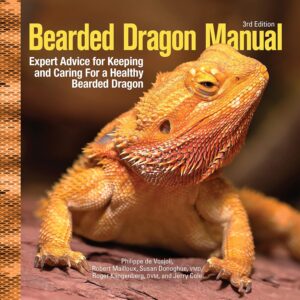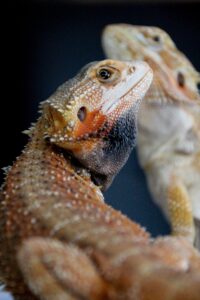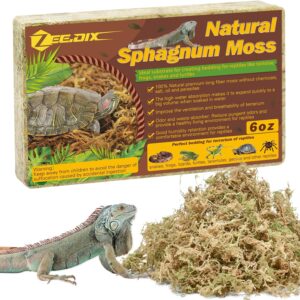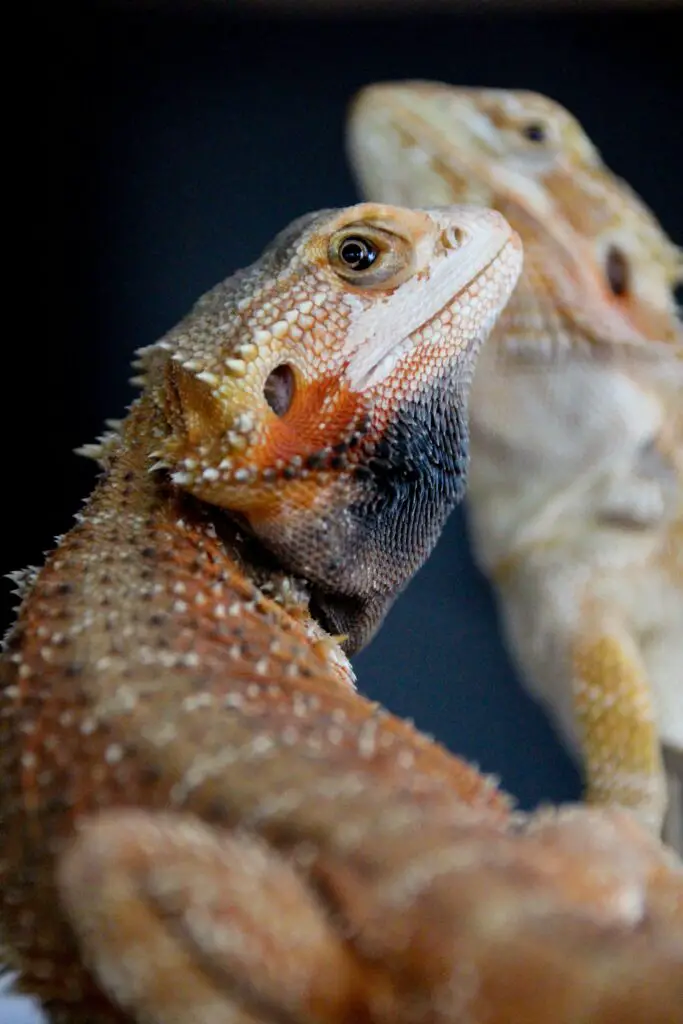Why is my bearded dragon black
Why is my bearded dragon black: Bearded dragons have become increasingly popular as reptile pets due to their unique appearance and fascinating behavior. These captivating creatures, belonging to the genus Pogona, are native to the arid regions of Australia. With their distinctive spiky appearance and calm temperament, bearded dragons have won the hearts of reptile enthusiasts worldwide.
However, even experienced bearded dragon owners sometimes encounter peculiar changes in their pet’s coloring. One particularly intriguing phenomenon is when a bearded dragon turns black.
This sudden transformation can leave owners perplexed and concerned about their beloved companion’s well-being. To shed light on this intriguing occurrence, we will delve into the reasons behind a bearded dragon’s black coloration and explore the various factors that could contribute to this striking change.
Brief Explanation of Bearded Dragons as Popular Reptile Pets
 Bearded dragons (Pogona vitticeps) are among the most popular reptiles kept as pets today. Their amiable nature, manageable size, and attractive appearance make them an excellent choice for both beginner and experienced reptile enthusiasts. These diurnal lizards derive their name from the impressive “beard” of spiky scales they display when feeling threatened or displaying dominance.
Bearded dragons (Pogona vitticeps) are among the most popular reptiles kept as pets today. Their amiable nature, manageable size, and attractive appearance make them an excellent choice for both beginner and experienced reptile enthusiasts. These diurnal lizards derive their name from the impressive “beard” of spiky scales they display when feeling threatened or displaying dominance.
Bearded dragons typically grow between 18-24 inches in length from head to tail and have a lifespan that can extend up to 10-15 years with proper care. They come in a wide variety of colors, including shades of beige, yellow, orange, red-brown, and even white or grayish hues depending on their morphs or natural variation.
Their calm demeanor makes them highly handleable pets that enjoy interaction with humans if provided with a suitable habitat that mimics their natural environment. Additionally, they are generally hardy creatures when provided with proper nutrition and environmental conditions.
Why is My Bearded Dragon Black? Intriguing Statement about a Bearded Dragon Turning Black
While bearded dragons are known for their vibrant and diverse coloration, witnessing a sudden and significant darkening of their skin can be both surprising and perplexing to owners. Imagine having a bearded dragon that typically displays hues of beige or yellow suddenly transform into a deep, almost black shade.
Such dramatic color changes often leave owners wondering about the underlying causes and whether there may be any underlying health concerns. The blackening of a bearded dragon’s skin can occur in certain situations such as during specific behaviors, under particular environmental conditions, or even as a result of health-related issues.
In some cases, the change in coloration is temporary and part of the normal behavior or physiological responses of bearded dragons. However, in rarer instances, prolonged black coloration may indicate an underlying health problem that demands attention.
In the subsequent sections, we will explore the various reasons behind this intriguing phenomenon to provide you with a comprehensive understanding of why your beloved bearded dragon may turn black. By delving into shedding processes, stress-induced changes, genetic factors, and potential health concerns related to black coloration in bearded dragons, we hope to equip you with practical knowledge for maintaining your pet’s well-being and ensuring its vibrant appearance remains intact.
Understanding Bearded Dragon Coloration
The Kaleidoscope of Natural Color Variations
Bearded dragons, those captivating reptiles that have charmed their way into our homes, exhibit a mesmerizing array of natural color variations. From vibrant oranges and sunny yellows to earthy browns and striking grays, these spectrums of hues make each individual bearded dragon a unique work of art. Within the broader family of Pogona, there are several species and subspecies with their own distinct color palettes.
The most common one is the Central Bearded Dragon (Pogona vitticeps), renowned for its warm earth tones and splashes of yellow radiating from its scales. However, other species like the Eastern Bearded Dragon (Pogona barbata) boast cooler hues with bluish-gray undertones blended harmoniously into their patterns.
The Enigmatic Role of Pigments in Reptile Skin Coloration
 To comprehend the intricacies behind bearded dragon coloration, we must delve into the fascinating world of pigmentation in reptiles. The colors we observe on their scales are predominantly attributed to three types of pigments: melanin, carotenoids, and structural colors. Melanin pigments are responsible for producing dark shades such as browns and blacks.
To comprehend the intricacies behind bearded dragon coloration, we must delve into the fascinating world of pigmentation in reptiles. The colors we observe on their scales are predominantly attributed to three types of pigments: melanin, carotenoids, and structural colors. Melanin pigments are responsible for producing dark shades such as browns and blacks.
These pigments are synthesized by specialized cells called melanocytes present in the skin layers. The intensity of melanin production determines whether an area appears dark or light.
In bearded dragons, elevated levels of melanin often result in patches or stripes that darken their overall appearance. Carotenoids, on the other hand, contribute to brighter colors like yellows and oranges.
These pigments are obtained through diet as bearded dragons consume plant matter rich in carotenoid compounds. Through complex metabolic processes within their bodies, these pigments become integrated into the reptile’s skin, transforming it into a vivid canvas of warm tones.
Structural colors create an illusion of vibrant hues without relying on pigments. These colors are produced through the reflection and refraction of light off specialized cells or scales present on the reptile’s skin.
While bearded dragons do not possess a prominent display of structural colors, their scales may occasionally exhibit iridescent sheens when caught in the right angle of light. Understanding the interplay between these pigments and how they manifest in various species and subspecies is crucial for comprehending why your bearded dragon may be turning black.
By deciphering their coloration mechanisms, we can shed light on this captivating phenomenon and its underlying causes. (Note: Remember to continue with sections 3-8 as per the outline provided earlier)
Description of the “beard” behavior and its impact on color change
Bearded dragons, scientifically known as Pogona vitticeps, possess a unique characteristic called the “beard” or “gular pouch.” This beard is a patch of skin located under their chin that can change color dramatically. When a bearded dragon is calm and content, its beard typically appears pale or even slightly yellowish. However, when they feel threatened or agitated, their beard undergoes a striking transformation and becomes dark black.
The darkening of the beard occurs due to specialized cells called chromatophores present in the skin of bearded dragons. These cells contain pigments that respond to external stimuli such as stress or fear.
When triggered by these emotions, the chromatophores release melanin, responsible for the black coloration in the beard. This reaction serves as an adaptive defense mechanism for bearded dragons to appear larger and more intimidating to potential predators.
Discussion on stress-induced darkening and its significance
Stress-induced darkening is another common reason why a bearded dragon’s coloration may turn black. Unlike the temporary color change caused by displaying their beard defensively, stress-induced darkening affects not only the beard but also spreads throughout their body.
When a bearded dragon feels stressed or anxious, it releases hormones that activate certain physiological responses leading to overall darkening of its skin pigmentation. It is crucial to address any sources of stress for your pet bearded dragon as prolonged exposure to stressful situations can have adverse effects on their health and well-being.
Common stressors include inadequate enclosure size, improper temperature regulation, lack of proper hiding spots or basking areas, loud noises or sudden movements in their environment, and even being housed with aggressive tank mates. If you notice your bearded dragon consistently displaying stress-induced darkening for extended periods without any apparent triggers present, it is important to consult a reptile veterinarian.
Chronic stress can weaken their immune system, making them more susceptible to various health issues, including respiratory infections and digestive problems. A thorough examination by a professional will help identify any underlying reasons for the persistent stress and ensure appropriate measures are taken to alleviate it.
The beard behavior in bearded dragons is a fascinating adaptation that allows them to communicate their emotions visually. The color change in their beard, from pale or yellowish to dark black, serves as a defensive mechanism when they feel threatened or agitated.
Additionally, stress-induced darkening can occur throughout their body when they are subjected to prolonged stressful situations. It is crucial for bearded dragon owners to understand these normal color changes and take necessary steps to minimize stressors in order to maintain the overall well-being of their scaly companions.
Shedding and Darkening Process in Bearded Dragons
Explanation of the Shedding Process in Reptiles, Including Bearded Dragons
Shedding, also known as molting or ecdysis, is a natural process that reptiles, including bearded dragons, undergo to replace their old skin. It is a crucial part of their growth and development.
As bearded dragons grow, their skin becomes tighter and less pliable. Shedding allows them to shed the outer layer of their epidermis and reveal a fresh layer underneath.
The shedding process typically begins with changes in the lizard’s behavior and appearance. You may notice your bearded dragon becoming more irritable or restless during this time.
Their skin may appear dull or opaque instead of its usual vibrant coloration. This initial stage known as pre-shed can last for several days before progressing to the actual shedding process.
Elaboration on How Shedding Can Cause Temporary Blackening
During shedding, it is not uncommon for bearded dragons to exhibit temporary blackening or darkening of their skin. This darkening occurs due to multiple factors associated with the shedding process.
One primary reason for temporary blackening is increased melanin production. Melanin is the pigment responsible for skin, hair, and eye color in reptiles as well as humans.
As a bearded dragon prepares to shed its old skin, melanocytes located in the basal layer of its epidermis become more active and produce additional melanin. This excess melanin can cause areas of darker pigmentation on its body, giving it a blackened appearance.
Additionally, during shedding, blood vessels close to the surface of the skin may constrict temporarily as new layers form underneath. This constriction reduces blood flow to certain areas and can contribute to localized darkening on various parts of the body.
It is important to note that this temporary blackening is a normal part of the shedding process and should not be a cause for concern. As the old skin loosens, the new layer beneath will eventually be revealed and your bearded dragon’s natural coloration will return.
Health Concerns Related to Black Coloration in Bearded Dragons
Respiratory Infections and their Impact on Skin Appearance
Prolonged black coloration in bearded dragons can sometimes be indicative of underlying health issues, particularly respiratory infections. Bearded dragons are highly susceptible to respiratory problems, which can arise from various factors such as inadequate humidity levels, poor ventilation, or exposure to cold temperatures.
When a bearded dragon’s respiratory system becomes compromised, it may struggle to breathe properly, leading to stress and subsequent skin darkening. Respiratory infections often result in the secretion of excess mucus that can obstruct the airways and impair normal breathing.
This increased mucus production can cause the bearded dragon’s skin to appear darker or even blotchy due to the inflammation and congestion occurring internally. Additionally, bacterial or fungal growth associated with respiratory infections may further contribute to skin discoloration.
If you notice your bearded dragon exhibiting black coloration along with symptoms like wheezing, coughing, excessive yawning, or labored breathing, it is crucial to consult a reptile veterinarian promptly. Early detection and appropriate treatment are essential for resolving respiratory infections and preventing any potential complications.
Parasitic Infestations Affecting Skin Condition
Another health concern associated with prolonged black coloration in bearded dragons is parasitic infestations that affect the skin condition of these reptiles. Bearded dragons can contract various parasites such as mites or ticks through indirect contact with infected objects or environments.
These parasites not only cause discomfort but also compromise the overall health of the reptile. Parasitic infestations often lead to itchiness and irritation for the affected bearded dragon.
As a result, they may scratch themselves excessively in an attempt to alleviate discomfort caused by these external parasites. Continuous scratching can damage their sensitive skin, leading to inflammation and darkening in the affected areas.
If you notice your bearded dragon displaying black patches accompanied by frequent scratching or visible signs of parasites like tiny moving specks on their skin or scales, it is crucial to seek veterinary care. A professional reptile veterinarian will evaluate the condition, perform necessary tests, and recommend appropriate treatment options to eradicate the parasites and improve your dragon’s overall health.
Prolonged black coloration in bearded dragons can be indicative of underlying health concerns. Respiratory infections can impact their skin appearance through increased mucus production and inflammation.
Similarly, parasitic infestations can cause itchiness and irritation, leading to excessive scratching and subsequent damage to the skin. Regular veterinary check-ups and proper husbandry practices are vital for maintaining optimal health in bearded dragons and preventing such health issues associated with black coloration.

Rare Cases: Genetic Factors Leading to Permanent Black Coloration
Introduction to genetic mutations causing permanent dark pigmentation in bearded dragons
In rare cases, some bearded dragons exhibit a permanent black coloration due to specific genetic mutations. These mutations alter the natural pigmentation process of their scales, resulting in a striking and unique appearance.
While most bearded dragons undergo temporary color changes due to environmental factors or physiological processes, these genetic mutations lead to a distinct and permanent black coloration that sets them apart from their counterparts. Understanding these rare cases can provide valuable insights into the fascinating world of reptilian genetics.
Exploration of specific gene mutations responsible for black coloration
One of the specific gene mutations responsible for permanent black coloration in bearded dragons is known as “melanism.” Melanin is the pigment responsible for dark colors in animals, including humans. In bearded dragons with melanism, there is an overproduction or altered distribution of melanin within their scales, resulting in a deep and consistent black hue throughout their body.
This mutation affects the expression of genes involved in melanin synthesis and deposition. Another gene mutation associated with permanent black coloration is referred to as “xanthism.” Xanthophores are responsible for yellow and orange pigments in reptiles, but when this mutation occurs, there is a suppression or absence of xanthophore development.
As a result, the yellow and orange tones typically found on bearded dragons are replaced with darker hues, often leading to an overall black appearance. It’s important to note that these genetic mutations leading to permanent black coloration are relatively rare occurrences among bearded dragons.
While they create visually striking individuals that stand out amongst others, they do not pose any health risks or concerns for the affected dragons. Instead, they offer both reptile enthusiasts and researchers alike a glimpse into the complex and captivating world of genetics, where nature’s palette can be diverse and unpredictable.
Caring for a Black Bearded Dragon
Proper Temperature and Lighting Requirements
 Maintaining the correct temperature and providing appropriate lighting are crucial aspects of caring for a black bearded dragon. These reptiles are ectothermic, which means they rely on external heat sources to regulate their body temperature. A basking spot should be provided within the enclosure, where the temperature ranges between 95-105°F (35-40°C) during the day.
Maintaining the correct temperature and providing appropriate lighting are crucial aspects of caring for a black bearded dragon. These reptiles are ectothermic, which means they rely on external heat sources to regulate their body temperature. A basking spot should be provided within the enclosure, where the temperature ranges between 95-105°F (35-40°C) during the day.
This area allows your black bearded dragon to thermoregulate by moving closer or further away from the heat source as needed. In addition to the basking spot, it is essential to establish a thermal gradient within the enclosure.
This means providing cooler areas around 75-85°F (24-29°C) to allow your bearded dragon to escape excessive heat and regulate its overall body temperature effectively. The use of thermostats or temperature controllers is highly recommended to ensure precise regulation.
Furthermore, adequate UVB lighting is vital for proper calcium metabolism in black bearded dragons. These reptiles require exposure to UVB rays for around 10-12 hours per day.
UVB light plays a crucial role in synthesizing Vitamin D3 in their skin, enabling them to absorb calcium from their diet effectively. Using high-quality UVB bulbs specifically designed for reptiles and ensuring they are replaced every six months will help maintain optimal health.
Appropriate Diet and Supplementation
Feeding your black bearded dragon a well-balanced diet is paramount to its overall health and coloration vibrancy. A varied diet consisting primarily of live insects such as crickets, roaches, mealworms, silkworms, or Dubia roaches is essential for these omnivorous reptiles. It is recommended that insects make up approximately 70% of their diet when they are juveniles and around 50% when they reach adulthood.
In addition to live insects, black bearded dragons should also be offered a variety of fresh vegetables and fruits. Leafy greens like kale, collard greens, mustard greens, or dandelion leaves provide essential vitamins and minerals.
Fruits such as strawberries, blueberries, or papaya can be offered occasionally as treats due to their higher sugar content. To ensure sufficient calcium intake, it is vital to dust the insects or coat them with calcium powder before feeding them to your black bearded dragon.
This helps prevent metabolic bone disease and ensures the proper development of bones and overall health. Furthermore, providing a high-quality reptile multivitamin supplement once or twice a week is recommended to meet any potential nutritional gaps in their diet.
By following these guidelines for temperature regulation and lighting as well as providing a well-balanced diet with appropriate supplementation, you can ensure optimal health and vibrant coloration for your black bearded dragon. Remember that regular veterinary check-ups are also essential to monitor their overall well-being and address any potential health concerns promptly.
Frequently Asked Questions about Black Bearded Dragons
Why is my bearded dragon black: Addressing common queries related to black coloration
One of the most frequently asked questions regarding black bearded dragons is, “Can a bearded dragon change its color permanently?” The answer to this question is both yes and no. While bearded dragons do have the ability to change their skin color temporarily, such as during periods of stress or shedding, permanent color changes are rare. It is important to understand that if your bearded dragon has turned permanently black, it may signify an underlying genetic mutation or health issue that should be addressed by a reptile veterinarian.
Another common query revolves around whether a black bearded dragon requires different care than its normal-colored counterparts. Generally, the care requirements for black bearded dragons are similar to those for other variations.
However, it is crucial to ensure proper husbandry practices that include providing appropriate temperature gradients and lighting conditions. Additionally, maintaining a balanced diet and offering necessary supplementation is essential for the overall health and well-being of your black bearded dragon.
To Sum Up Why Is My Bearded Dragon Black
Observing a black-colored bearded dragon can evoke curiosity and concern among reptile enthusiasts. While temporary changes in coloration can occur due to shedding or stress, permanent black coloration in these reptiles is uncommon and may indicate an underlying genetic mutation or health issue. As responsible pet owners, it is important to monitor our bearded dragons’ skin condition closely and provide optimal care tailored to their specific needs.
By ensuring proper husbandry practices and seeking veterinary attention when necessary, we can maintain the well-being of these captivating creatures. Embrace the uniqueness of your black bearded dragon while providing them with a safe and comfortable environment for a long and vibrant life!
Further Reading:
- Carolina Custom Cages Terrarium Review
- 8 Best Basking Rocks for Beardie: What Is the Best Choice?
- 10 Best Thermometers for Beardie: How to Choose the Best One?
- 5 Best Beardie Lighting Setups for Beardie Lovers
- 9 Best Heat Lamps for Beardie: Natural Habitat Provided


